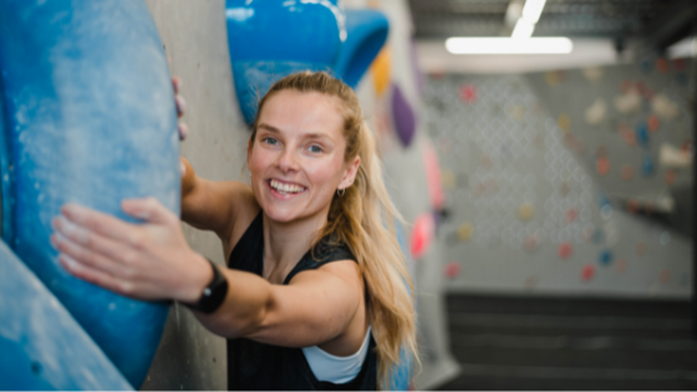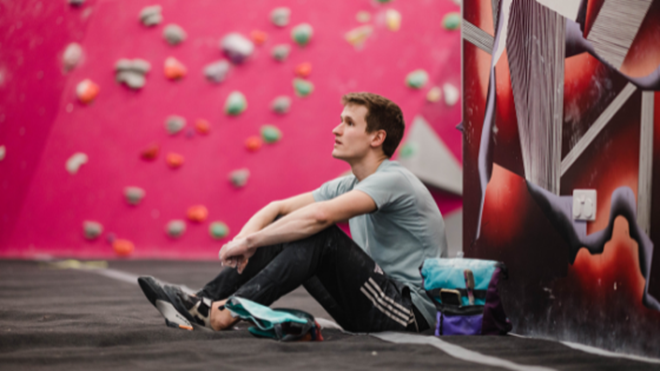5 quick changes to make a big difference to your climbing
Climbing is all about small, incremental improvements that leads to big gains in your climbing. 5 small changes you make every time you go climbing could drastically improve your climbing. As the saying goes, Rome wasn't built in a day, it will take time to improve. However, with consistency and dedication, these simple changes will start making a big difference in your climbing.
If you are new to climbing, you might also be interested in our indoor climbing wall etiquette blog.
1. Always warm up
We cannot stress the importance of warming up before climb enough! Not only does warming up drastically decrease your risk of injury, but it will also make your climb a much more enjoyable experience without the stiffness of cold muscles getting in the way of performance. We recommend doing a little floor work to stretch and open your shoulders, hips, and ankles for at least 30 seconds each side and then climbing no less than 3-4 lower grades climbs. Think of moving each limb in circular motion starting from the top and work your way down.

2. Learn how to manipulate gravity
It’s time to stop thinking about gravity as the enemy. Yes, we all love a low-gravity day in the Hangar but sometimes it does not play out that way. But did you know, you can make gravity work for you?
When pulling for a hold that is a little out of reach, many people pull themselves as close as they can to the hold they have reach and try to stretch or smear their feet but to no avail.
Think about bouncing on a trampoline… there is a moment at the very top of the jump, just before falling back down, where you feel weightless – the same concept applies in climbing. Rather than statically reaching for the next hold, putting a lot of pressure on one arm to hold you up, try bending your legs, straightening your arms and then quickly straighten your legs and reach for the next hold, think of taking off like a rocket. The momentum from straightening your legs will power you up to the hold you are looking at and you can continue the climb.
3. Body positioning and footwork
If we were to magically transport you to the top of the wall and asked you to climb down, you would immediately look down at your feet. This is a normal reaction and is in response to wanting to know what you are stepping down on to. So, doesn’t it make sense to do the same on the way up? To be more accurate with your footwork, look at your feet and watch them all the way onto the hold. Practicing this during your warmup, on easier blocs, means that you can get the movement right as the climbing is not too complicated.
Where does your movement start from? Get someone to have a look when you are next pulling on. Are you pulling with your arms first or do you push from your legs? Most of our movement should be coming from our legs as they are much stronger and will have better endurance. Practice moving your feet up first, then move your arms up – think ‘step, step, reach reach’.
Be mindful of keeping your hips over your feet. This way, gravity will pull your mass down over your big leg muscles, rather than your arms keeping you up.

4. Listen to your body and mind
This sounds like an obvious one, but sometimes our drive to complete a certain project and/ or reach the top of a climb makes us oblivious to the signals our body is putting out.
Make sure you take time to read the route before jumping on it, take plenty of rests between attempts. At this point we should also be considering brushing the holds we are going to use, chalk is for hands not holds, after all!
It is also the time of year to be checking your skin condition on your hands. As it is getting warmer, we are more likely to have sweatier, more oily skin. We use more chalk which will in turn dry our skin out. So, make sure you wash your hands after your session and apply a light moisturiser to supplement.
Nothing makes climbing less enjoyable that getting too in your own head about what you came to achieve on that session, learn to acknowledge when your head is not in it and to try another day. The no.1 aim more than anything else should be to enjoy yourself! We all have off days and most of the time, the best remedy is just to climb what you enjoy instead of pushing your body to its limits (and then grab a pizza or toastie and relax after your session).
5. Get a coach
The best way to improve your climbing is by focusing on technique rather than strength or power. This will help avoid injury and allow you to climb longer without getting tired.
Our one-to-one climbing coach sessions (or one to two, since training with friends is important) can help you push through plateaus with focused practice, new techniques, and increased confidence. They will also help you develop problem solving skills and techniques that can be used in a variety of climbing contexts.
We design these sessions to suit your needs and goals. If you are looking for a specific skill or technique, let us know at the time of booking and we will tailor the session to suit.
If 1-1 coaching is not for you, we also have group coaching sessions and various fun, social group sessions led by our Hangar coaches, like Hangar Women Rock.
Coaching for every level of climber
Not matter whether you're a complete beginner, or you're plateauing at purples, our group coaching sessions can help improve your climbing form and make you a more consistent and efficient climber.
